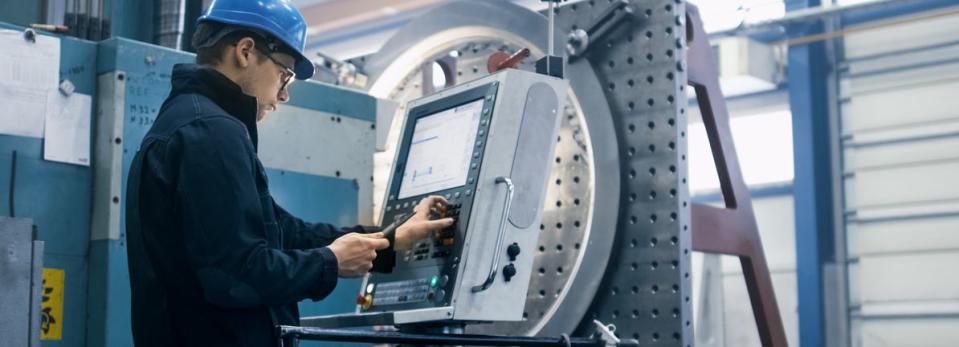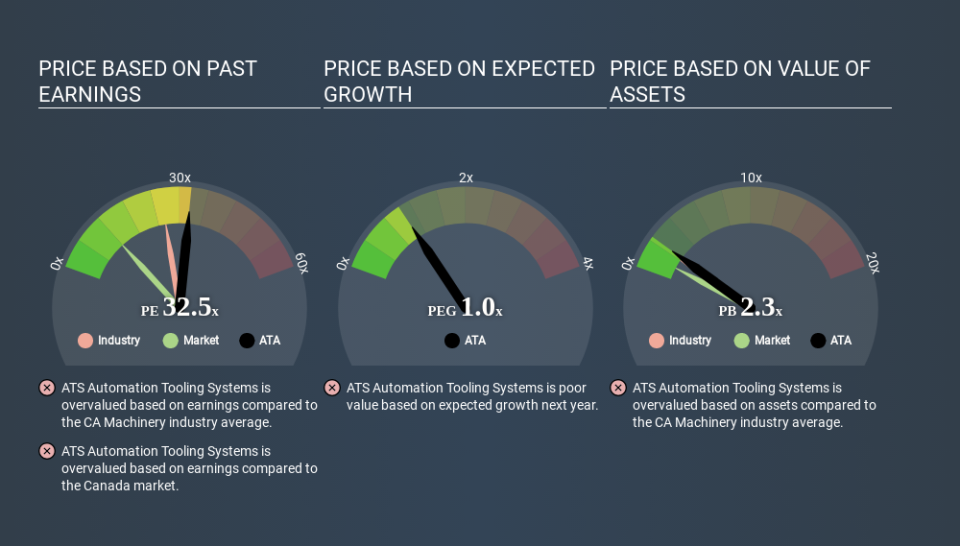What Is ATS Automation Tooling Systems's (TSE:ATA) P/E Ratio After Its Share Price Rocketed?

ATS Automation Tooling Systems (TSE:ATA) shareholders are no doubt pleased to see that the share price has had a great month, posting a 37% gain, recovering from prior weakness. The bad news is that even after that recovery shareholders are still underwater by about 3.7% for the full year.
All else being equal, a sharp share price increase should make a stock less attractive to potential investors. While the market sentiment towards a stock is very changeable, in the long run, the share price will tend to move in the same direction as earnings per share. So some would prefer to hold off buying when there is a lot of optimism towards a stock. Perhaps the simplest way to get a read on investors' expectations of a business is to look at its Price to Earnings Ratio (PE Ratio). A high P/E ratio means that investors have a high expectation about future growth, while a low P/E ratio means they have low expectations about future growth.
View our latest analysis for ATS Automation Tooling Systems
How Does ATS Automation Tooling Systems's P/E Ratio Compare To Its Peers?
We can tell from its P/E ratio of 32.46 that there is some investor optimism about ATS Automation Tooling Systems. As you can see below, ATS Automation Tooling Systems has a higher P/E than the average company (26.0) in the machinery industry.
That means that the market expects ATS Automation Tooling Systems will outperform other companies in its industry. The market is optimistic about the future, but that doesn't guarantee future growth. So investors should delve deeper. I like to check if company insiders have been buying or selling.
How Growth Rates Impact P/E Ratios
Probably the most important factor in determining what P/E a company trades on is the earnings growth. When earnings grow, the 'E' increases, over time. And in that case, the P/E ratio itself will drop rather quickly. Then, a lower P/E should attract more buyers, pushing the share price up.
ATS Automation Tooling Systems's earnings per share fell by 12% in the last twelve months. But over the longer term (5 years) earnings per share have increased by 9.4%.
Don't Forget: The P/E Does Not Account For Debt or Bank Deposits
It's important to note that the P/E ratio considers the market capitalization, not the enterprise value. That means it doesn't take debt or cash into account. The exact same company would hypothetically deserve a higher P/E ratio if it had a strong balance sheet, than if it had a weak one with lots of debt, because a cashed up company can spend on growth.
Such expenditure might be good or bad, in the long term, but the point here is that the balance sheet is not reflected by this ratio.
So What Does ATS Automation Tooling Systems's Balance Sheet Tell Us?
ATS Automation Tooling Systems's net debt is 11% of its market cap. This could bring some additional risk, and reduce the number of investment options for management; worth remembering if you compare its P/E to businesses without debt.
The Bottom Line On ATS Automation Tooling Systems's P/E Ratio
ATS Automation Tooling Systems's P/E is 32.5 which is above average (11.9) in its market. With a bit of debt, but a lack of recent growth, it's safe to say the market is expecting improved profit performance from the company, in the next few years. What we know for sure is that investors have become much more excited about ATS Automation Tooling Systems recently, since they have pushed its P/E ratio from 23.7 to 32.5 over the last month. For those who prefer to invest with the flow of momentum, that might mean it's time to put the stock on a watchlist, or research it. But the contrarian may see it as a missed opportunity.
Investors should be looking to buy stocks that the market is wrong about. If the reality for a company is better than it expects, you can make money by buying and holding for the long term. So this free report on the analyst consensus forecasts could help you make a master move on this stock.
Of course, you might find a fantastic investment by looking at a few good candidates. So take a peek at this free list of companies with modest (or no) debt, trading on a P/E below 20.
If you spot an error that warrants correction, please contact the editor at editorial-team@simplywallst.com. This article by Simply Wall St is general in nature. It does not constitute a recommendation to buy or sell any stock, and does not take account of your objectives, or your financial situation. Simply Wall St has no position in the stocks mentioned.
We aim to bring you long-term focused research analysis driven by fundamental data. Note that our analysis may not factor in the latest price-sensitive company announcements or qualitative material. Thank you for reading.

